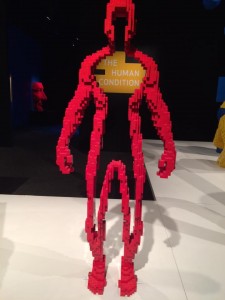Taking advantage of a gap in my schedule, I squeezed into the city to see an exhibit I have been dying to visit before the city essentially shuts down for the Papal visit. Philadelphia has gone into over-drive preparing for the historic visit; closing some train stations, roads, and bridges to try and handle the enormous crowds expected in Center City. Despite the increased number of people in the city, the Franklin Institute was nearly empty! Having been at the museum when it was so crowded we were packed in like sardines, it was a pleasant surprise.
Last winter, an exhibit called the Art of the Brick (AOTB) made its way to the Franklin Institute for a limited engagement. I intended to see it, but my crazy semester got the best of my time, and I didn’t get to before I left for summer. To my surprise, when I arrived back in the fall, I heard that it had been extended by “popular demand”. I assumed it was so popular because of the novelty of the exhibit; its creator Nathan Sawaya said himself that he started making Lego artwork because it hadn’t been done before. But when I stepped into the exhibit, I immediately understood why it had such staying power.

Nathan Sawaya has done much more than recreate famous masterpieces using small, brightly colored pieces of children’s toys; he has created a way to draw emotion from the people visiting his exhibit and even more deeply, to bring them together. After going through the first two halls where there were recreations of Leonardo da Vinci’s Mona Lisa, Michelangelo’s David, and Vincent van Gogh’s Starry Night to just name a few, the final hall contained pieces original to the curator.
 Entitled “The Human Condition”, each one had a description with a message from Sawaya about the meaning behind each installment. One of the most amazing elements of the exhibit was how I could see myself in each one of his original creations. He drew on sentiments so common and relevant to our society that you couldn’t help but have your breath taken away and emotions tugged at. Everything from diversity to finding our own voice was beautifully built into human form with hundreds of thousands of Legos as unique as we are.
Entitled “The Human Condition”, each one had a description with a message from Sawaya about the meaning behind each installment. One of the most amazing elements of the exhibit was how I could see myself in each one of his original creations. He drew on sentiments so common and relevant to our society that you couldn’t help but have your breath taken away and emotions tugged at. Everything from diversity to finding our own voice was beautifully built into human form with hundreds of thousands of Legos as unique as we are.
My words can only speak to a fraction of the meaning behind this exhibit and so if the Art of the Brick comes to a museum near you, I wholeheartedly recommend you see it. I would like to end this post with a picture of my favorite piece. It is just one of the many creations in the AOTB that collectively represent the creativity, inspiration, and hope of this exhibit. In the description next to it, Nathan Sawaya writes,
 “Celebrate difference. If everybody looked and was the same, it wouldn’t be a very interesting world, would it? So which shape are you? And which color? The circle, square, and triangle are the fundamental building blocks of all things. And the colors red, blue, and yellow are the primary colors of our world.”
“Celebrate difference. If everybody looked and was the same, it wouldn’t be a very interesting world, would it? So which shape are you? And which color? The circle, square, and triangle are the fundamental building blocks of all things. And the colors red, blue, and yellow are the primary colors of our world.”



 This past Friday, one of my best friends and I had to pick up some things from the grocery store that would have been too heavy to walk back to school with, so I finally faced my fear and drove! My car’s name was Dionne and at my scheduled time, all I had to do was waive my Zipcar membership card over the reader on the dashboard and voila, I had my own four wheels for an hour. It’s such a neat concept! I wasn’t used to driving a small car with a *very* sensitive gas petal, but overall, the experience was very pleasant (I hope my friend thinks so too!) and my confidence even grew a little. Now, I admit Lancaster Ave. is no Interstate 76, but baby steps. With this new found freedom, who knows where I’ll be off to next. And hey, I only received one Northeastern hello.
This past Friday, one of my best friends and I had to pick up some things from the grocery store that would have been too heavy to walk back to school with, so I finally faced my fear and drove! My car’s name was Dionne and at my scheduled time, all I had to do was waive my Zipcar membership card over the reader on the dashboard and voila, I had my own four wheels for an hour. It’s such a neat concept! I wasn’t used to driving a small car with a *very* sensitive gas petal, but overall, the experience was very pleasant (I hope my friend thinks so too!) and my confidence even grew a little. Now, I admit Lancaster Ave. is no Interstate 76, but baby steps. With this new found freedom, who knows where I’ll be off to next. And hey, I only received one Northeastern hello.